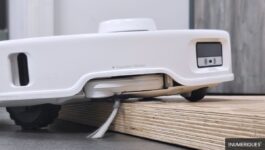
Lab – Can the Roborock Qrevo Curv really climb small steps?
Roborock Qrevo Curv
Introductory price €1499
Turn off your ad blocker to access all of the links above.
The Qrevo Curv is Roborock's latest high-end robot vacuum cleaner. As such, it brings some new features, one of which is its AdaptiLift chassis which can be raised to overcome obstacles up to 4 cm high… under certain conditions.
This maximum height is actually given for “complex double-layer thresholds”broken down into a first layer of 3 cm and a second of 1 cm. Suffice it to say that you shouldn't expect to see the Qrevo Curv climb stairs, but it should be able to easily cross most threshold bars and climb on even very thick carpets. AdaptiLift would also make it possible to increase the efficiency of the suction on these very thick carpets by preventing their hair from obstructing the suction mouth… Well, all that is the theory. Now it’s time to practice!
The Qrevo Curv arrived at the editorial office Digital some time ago. You can also consult our complete online testbut our protocol does not provide a sufficiently high challenge to put Roborock's latest innovation to the test. We therefore had to innovate in our turn.
The Qrevo Curv can be lifted on its three wheels. © Les Numériques
We finally found an ideal board for the exercise. Peaking at around 3 cm, it creates a small difference in level in our lab. We placed it on the ground before launching the robot on an area straddling our two levels. The robot vacuum cleaner then begins by going around the latter, but interrupts it by coming up against the board. Instead of riding it, or at least trying to, he simply changes direction, then ends up going around the board while continuing to tap against its edge. It's a disappointment. It is finally necessary to add a threshold on the map for him to attempt the ascent.
With a little, almost cute noise, the Qrevo Curv starts by pushing on its front wheel to raise its bumper and rushes towards the board. The front of the robot passes, but one wheel remains against it. Far from being disassembled, the Curv deploys the extension of the last wheel and finally manages to mount entirely on the board. It is therefore a successful mission, although not without difficulty.
The robot further decides to go down before even cleaning, then returns to its station as if it had finished. Damage. In its defense, the surface to be swept on the board is rather small and the difficulties in getting on it can probably be explained by its raw edges — a threshold bar does not generally form right angles.
The Qrevo Curv had to be done twice to get on our board. © Les Numériques
If we take the initial promise, the Qrevo Curv is certainly not doing so badly. We have not found any other robots capable of riding our board. But what about the use case? It seems rare to us to have thresholds of 3 cm height in a house and most devices do very well with thresholds of up to 2 cm. So this doesn't seem like a significant improvement to us, in terms of navigating the home anyway.
In terms of suction, the Qrevo Curv does not seem to consider our test mats thick enough to find it useful to lift its chassis when passing over them, but remember that it obtained excellent results during our tests . We therefore do not expect any big improvement. The latest Qrevo is undeniably a good robot, but its AdaptiLift chassis definitely doesn't have much to do with it.





